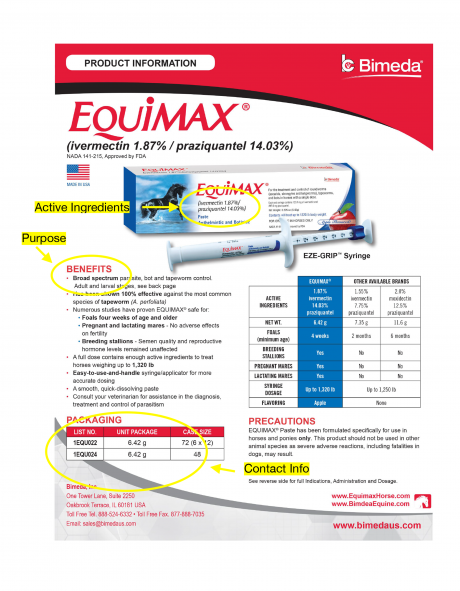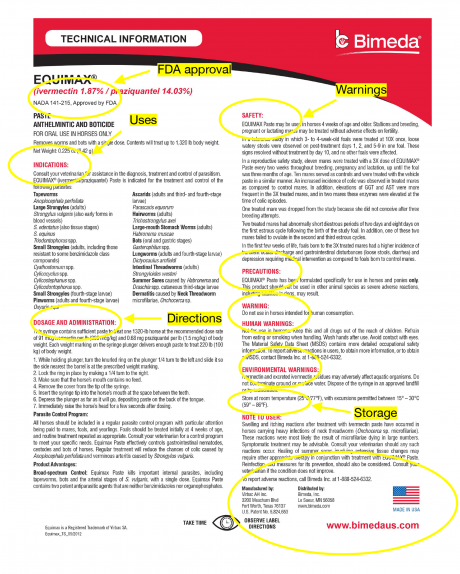Counterfeit Medicines: If It Sounds Too Good To Be True…
 Subject line: "We are back with Original ______________." The email caught my attention. Read on…" This is not the watery brand." Hmmm…thickening agents…corn starch, flour…?
Subject line: "We are back with Original ______________." The email caught my attention. Read on…" This is not the watery brand." Hmmm…thickening agents…corn starch, flour…?
INTRODUCTION
Counterfeit and bogus medications are a troubling issue for both people and livestock. A fake or counterfeit medicine could have no active ingredient, substandard ingredients, undeclared ingredients, illegal or dangerous ingredients, incorrect dosage, or contaminants from unhygienic manufacture. The result to the patient or livestock ranges from lack of effectiveness to severe adverse reactions to untimely death.
ETIOLOGY
Contributing reasons for bogus medication include today's globalized pharmaceutical supply chain, further complicated by online pharmacy sources and realistic reproductions of products. The economic impact of all counterfeit medicines is difficult to ascertain. Some researchers found that the annual cost might run anywhere from $10 billion to $200 billion for bogus human and animal drugs.
PREVALENCE
In one met analysis of 20 studies, the authors identified that 52% of the 1246 veterinary medicine samples collected in Asia and Africa tested for quality were substandard or falsified. The most common reason for sample failure was out-of-specification active ingredient(s) content (46.6%, 481/1032), and 4.2% of all samples contained incorrect active ingredient(s). The results do not mean that 52% of veterinary medicines are counterfeit globally. But rather, substandard veterinary medicines may be a serious public health problem, especially in low-income and middle-income countries, with little evidence of their occurrence in high-income countries.
WHO estimates that 50% of the drugs for sale on the internet are fake, and even though the online dispensaries might look legitimate, a survey of 10,000 of them done by America's National Association of Boards of Pharmacy (NABP) found that 9938 did not comply with NABP patient safety and pharmacy practice standards or US state and federal laws. “Most said they were based in Canada but were a front for illegal offshore operations.
But how do you tell if a website and medication is bogus? One option is to send the suspected drug to a lab for content testing and analysis. This approach is an unappealing option for many consumers due to cost and availability. In the US, pharmaceutical content analysis design is for a company’s R&D team rather than consumer use. The implementation of FDA regulations and monitoring systems in the US means less than 1% of US manufactured medicines sold are counterfeit. Unfortunately, the problem of counterfeit medicines in the US takes a different spin once pharmaceutical compounds are purchased online. The US FDA does not have jurisdiction over companies not housed in the US. That means a potential problem for consumers who buy online. Nearly half of Americans (42%) are currently purchasing medications online largely due to perceived benefits of convenience and cost. The key word here is “manufactured” meaning they must follow FDA regulations.Lab testing in developing countries is a critical need.
In the future, companies are developing low technology such as the Paper Analytical Device (PAD). The PAD may allow care providers to test fake drugs on the spot and at a fraction of the cost of standard lab testing. This is being tested in low income populations.
WEBSITE AUTHENTICITY
Instead, we must rely on website authenticity indicators, proper medication labeling, and Pharmacy Board seal of approval. Look for the Veterinary-Verified Internet Pharmacy Practice Sites (Vet-VIPPS) seal of approval from the National Association of Boards of Pharmacy (NABP). This seal of approval identifies to the public those online pharmacy practice sites that are appropriately licensed, legitimately operating via the Internet, and have completed a rigorous criteria review and evaluation.
Unfortunately, many legitimate companies do not apply for VIPPS or PCAB approval. The approval process is costly and time-consuming. In 2012, only 18 online veterinary medication manufacturers received approval. This number increased to 349 in 2023. Click links below for listings.
Digital Pharmacy Accredited pharmacies
Not Recommended Pharmaceutical Sites
Another way to find a verified website is to look for .pharmacy at the end of the web address. When a website ends in .pharmacy, it has been verified by NABP. Unlike logos, the .pharmacy domain cannot be faked or forged.
There are a few other ways to evaluate website authenticity. The FDA has the following suggestions for protecting yourself when purchasing pet medications online, using the acronym AWARE:
1. Ask your veterinarian if she/he knows anything about the website.
2. Watch for red flags, such as not requiring a prescription, not listing an address and phone number, or not having a pharmacist available to answer questions.
3. Always check for site accreditation, such as from Vet-VIPPS.
4. Report problems and suspicious online pharmacies. They suggest reporting any problems first to the manufacturer and then to the FDA's Center for Veterinary Medicine
5. Educate yourself about online pharmacies.
6. Use common sense when purchasing medications online; if a deal seems too good, you're likely not getting the real thing.
MEDICATION LABELING
The FDA sets requirements for medication package labeling for both prescription and non-prescription (over-the-counter) human and animal drugs. A list of required information for nonprescription labels and package inserts includes
1. Active Ingredient-therapeutic substance in product; amount of active ingredient per unit.
2. Uses-symptoms or diseases the product will treat or prevent.
3. Warnings-when not to use the product; conditions that may require advice from a doctor before taking the product; possible interactions or side effects; when to stop taking the product and when to contact a doctor; if you are pregnant or breastfeeding, seek guidance from a health care professional; keep product out of children’s reach.
4. Inactive Ingredients-substances such as colors or flavors.
5. Purpose-product action or category (such as antihistamine, antacid, or cough suppressant.
6. Directions-specific age categories, how much to take, how to take, and how often and how long to take.
7. Other Information-how to store the product properly and required information about certain ingredients (such as the amount of calcium, potassium, or sodium the product contains)
Figures 1and 2 show a package insert for a correctly labeled nonprescription medication.


Summary
Bogus and counterfeit medications are a significant concern in many countries. Their infiltration into the online pharmaceutical supply chain is an increasing problem for human and livestock medicines. Lab testing is not easy nor financially attractive for consumers to validate authenticity. Reporting to the proper agencies and educating ourselves on US FDA requirements for labeling and websites is essential in moving through the world's pharmaceutical supply chain.
References
Lopez, Michael J., Tadi, Presanna, 2022, Drug Labeling, Treasure Island (FL): StatPearls Publishing;
Dept of Health and Aged Care, Australian Government, 2020, How To Spot a Counterfeit Medicine.
Counterfeit Drugs: A Growing Global Threat, (2015). The Lancet, Vol 379, Issue 9817, 685.
National Association of Boards of Pharmacy, www.Safe.Pharmacy
FDA, Reporting for Veterinarians and Consumers. www.fda.gov/animal-veterinary/safety-health.
FDA, Quick Tips for Buying Medicines Over the Internet.
FDA, BeSafeRx: Your Source for Online Pharmacy Information.
FDA, the Over the Counter Medicine Label: Take a Look.
PADproject.nd.edu, University of Notre Dame.
Vidhamaly, V, Bellingham, K, Newton, P., Caillet, C. The quality of veterinary medicines and their implications for One Health (2022), NIH.
CDC, www.cdc.gov. Counterfeit Medicines, Travelers’ Health.
National Association of Boards of Pharmacy www.NABP.Pharmacy
